#the only modern Jekyll and Hyde we have is from The League of Extraordinary Gentlemen
Text
There is a dark truth in me. One that I cannot bear any longer. Some secret scratched deep on these bones since the day I was born:
We don't need another Gladiator movie, because the first said everything it needed to.
Please, Universal, let dead Maximus's lie, and how about a new IP? I'm still waiting on Doctor Jekyll and Mr Hyde...
#poetry#pretty good movie ngl#film#please universal#the only modern Jekyll and Hyde we have is from The League of Extraordinary Gentlemen#its time#pretty pls
11 notes
·
View notes
Note
I first saw Hyde being giant unhinged monster in different western comics and then manga, but in classic old time movies he's probably due to limitations closer to a normal guy looks wise but then you get movies where he is a giant beast breaking chains and walls and for some reason roars a lot?
I'm catching up on old Asks right now, and for context, I think this was from when I wrote a post about how it's interesting that it seems to be a popular perception that Hyde in adaptations is overwhelmingly portrayed as a large monster comparable to the Hulk in character design, even though I don't think that's really the case, especially if we're looking at live-action film and television adaptations!
But yeah, I would say that Hyde in classic films and even modern television shows is usually the Jekyll actor wearing make-up and changing their body language, which is both closer to the novella and within the realm of what old special effects can achieve, and I can only think of two giant beast monster Hydes in movies, which are from The League of Extraordinary Gentlemen (2003) and Van Helsing (2004), with that description above best matching the former - and it's just fascinating bc these are two movies that are twenty years old now, and while Van Helsing has a cult following, the LXG film was a flop with no long-term cultural impact, and yet, these two versions somehow have had a very lasting influence on people's perceptions of Hyde interpretations in film.
Also, I have no idea what the idea behind the VH!Hyde is beyond being a monster for VH to hunt down in an action scene, but for the LXG film, I would say he is a giant monster is bc (a) the movie takes place after the novella, and in the source material, Jekyll does mention in his final statement that Hyde has been growing in stature, though we can obviously debate just how big he would have gotten, and (b) while I think calling LXG!Hyde the Victorian Hulk is a convenient shorthand, but somewhat reductive, the League concept is supposed to be a parody or play on the modern comic book superhero team, in which there is usually a Big Guy for brute force (eg. Hulk for the Avengers, Ben Grimm for the Fantastic Four) and that's the role Hyde plays in the League, and it's also a reference to how the Hulk himself was inspired by Jekyll and Hyde (and Frankenstein's Creature), so it's interesting meta commentary that comes full circle too.
8 notes
·
View notes
Text
The Contention of Voice: Alan Moore’s Reshaping of Mr. Hyde’s Monstrosity ••• By Lissa Heineman
Having now completed The League of Extraordinary Gentleman’s fourth volume, it is possible comic culture’s favorite uncle, Alan Moore, is officially retiring from comics. The graphic novel series is celebrated for its gallery of famous characters from literary history, acting as a new-age compendium for Industrial Revolution-centric anachronisms. It’s both a Lit Degree-er’s nightmare and playground, remixing themes and characteristics from different classic works together. One such example is Moore’s take on the OG, 1800′s Hulk, Dr. Jekyll/Mr. Hyde.
Robert Louis Stevenson’s The Strange Case of Dr. Jekyll and Mr. Hyde was published in 1886, a time in which the debate around science and religion was intense. Charles Darwin’s The Origin of Species had been released in 1859 and made the Victorians begin to question their ‘infallible’ faith in God’s unlimited control, but also be wary of metaphysical sciences — a phenomena that studies the fundamental nature of reality. The book used its main characters to generate discourse about morality, reasoning, science, and faith, while reflecting upon the growing uncertainties that came with fin-de-siecle, or end-of-the-century, culture. To the modern reader, the basic message of Stevenson’s novel is clear: Hyde wasn’t simply a monster, and consequence of metaphysical practices, but a manifestation of Dr. Jekyll’s repressed self. However, this leaves a question of how human Hyde is in comparison to Dr. Jekyll, if they are one in the same. What is Mr. Hyde’s personhood? It is through the introduction of Alan Moore’s take on the character(s), that Mr. Hyde’s own character takes shape. By integrating characteristics of Edgar Allan Poe’s The Murder in the Rue Morgue into Hyde’s storyline, Moore argues for Hyde’s personhood and agency, not allowing him to simply be a figure of the Victorian’s metaphysical anxieties.
In Dr. Jekyll and Mr. Hyde, Jekyll is described as having become “too fanciful… [and going] wrong in mind,” practicing “unscientific balderdash” (Stevenson 12). Jekyll is framed as immoral, particularly in comparison to the book’s protagonists. His ‘science’ is described as “transcendental medicine” (Stevenson 52), ie: metaphysical inquiries. Jekyll’s research, and his addiction to his own chemicals, code him as a heretic. Stevenson indicates that Jekyll, himself, is problematic. Yes, Hyde is young and brutish with more physical capabilities than the older, deteriorating Dr. Jekyll, but he certainly isn’t the degenerative juggernaut illustrated in The League of Extraordinary Gentlemen. Rather, Mr. Hyde is described as “troglodytic” (Stevenson 16), “ape-like” (Stevenson 20), and “a monkey” (Stevenson 39). These descriptions of Mr. Hyde allude to the backwards progression of man’s evolution, as chronicled by Charles Darwin and the likes of Thomas Henry Huxley, reaffirming Jekyll as representative of a bastardization of London’s moral ideals of the time.
The League of Extraordinary Gentlemen clearly takes some creative liberties with its depiction of Mr. Hyde. In Issue 1, Hyde is seen easily holding Quatermain feet above the ground, close to the ceiling, easily in one hand, fangs barred and tendons and veins practically bursting across his collar and face. Across the same two-page spread, Auguste Dupin attempts to defend himself and Mina Murray from Hyde, shooting the monster in the face. Part of Hyde’s ear is blown off, which only increases Hyde’s anger, emphasized by the all-capitalized dialogue bubbles. Not only does Hyde retain the apishness described in Stevenson’s novel, but it is intensified, as seen via the fangs, flared nostrils, incredible muscle definition, and the overall brownishness of his complexion. He towers over all the other characters dramatically, alluding more to King Kong than how earlier adaptations had illustrated the character, which often emphasized “neanderthal” over “monkey”. Hyde was popularly depicted as an unkempt, twisted, and hunching man across films and drawings. There can be many reasons for this deviation within the comic’s universe, but one of the most obvious links is in how this Hyde is adapted not only from Stevenson’s work, but also Edgar Allan Poe’s The Murders in the Rue Morgue. The murders attributed to Hyde by Dupin in The League are ones that were committed by the Ourang-Outang in Poe’s short story. Even the way that Hyde’s anger increases when Dupin shoots him mirrors how the Ourang-Outang becomes agitated enough to murder the two women, which occured only when one of the women provoked it by screaming (Poe 35). Moore masterfully blends together Hyde and the Ourang-Outang to display the animalistic qualities of the former character.
However, what is most interesting regarding Hyde in The League is his communication -- his literal ability to speak. Never at a single point in Dr. Jekyll and Mr. Hyde does Mr. Hyde speak; we only hear Dr. Jekyll himself talk. A large part of Poe’s Rue Morgue mystery is based in “voices in... contention” (first on Poe 11). Witnesses heard the then-mysterious “arguing” of the deep-voiced French sailor and the shrill shrieking of the Ourang-Outang, and found the ape’s voice to be unidentifiable in gender and nationality. Dupin notes that:
"the voices of madmen, even in their wildest paroxysms, are never found to tally with that peculiar voice heard upon the stairs. Madmen are of some nation, and their language, however incoherent in its words, has always the coherence of syllabification” (Poe 28-29).
Poe introduces the idea that language is a characteristic of a nation, and therefore language being linked to personhood. It is this argument that leads to Dupin’s logical deduction that the murderer couldn’t have been human at all, as he didn’t have language or nation, and it is this language that brings us to question the boundaries between both Stevenson and Moore’s version of Jekyll, Hyde, and their divide.
Stevenson’s Mr. Hyde is a ‘mask’ for Dr. Jekyll; we never engage in Mr. Hyde’s perspective, and while Dr. Jekyll uses the potion to maintain control over both himself and his alternate-persona, we are never given evidence that Hyde himself has his own perspective. Hyde’s activities across the novel are described as bouts of rage that mirror the kind of blind activity that the Ourang-Outang perform: they are mindless performances of heated passion and emotion. On the other hand, Dr. Jekyll’s role is indisputable. In his confession of the murders in Stevenson’s novel he admits that he “mauled the unresisting body” (Stevenson 60), rather than referring to himself as Mr. Hyde, which would relieve himself of blame or control. This reaffirms Hyde as a costume for Jekyll’s depravities. Even in the final chapter, “Henry Jekyll’s Full Statement of the Case”, where Dr. Hyde’s body is “in control”, the character still refers to himself exclusively as Dr. Jekyll. Dr. Hyde is never autonomous, and he is never a singular being. These facts create a gap in how to read Mr. Hyde at all, because despite his own embodiment, he is very much just Dr. Jekyll.
Despite performing similar brutalities to Poe’s monster, Hyde/Jekyll is very human. However, when he’s offered a voice by Moore, Hyde becomes separate. Jekyll isn’t speaking through Hyde, and Moore’s Hyde becomes a near-replica of the dynamics that Marvel’s Bruce Banner and the Hulk engage with, as well as that of Poe’s Ourang-Outang and the Frenchman, who feared being accused as guilty for the crimes of the ape. Such dynamics are further displayed by Moore in Champion Bond’s explanation of Jekyll/Hyde. He describes Dr. Jekyll as “a highly moral individual” who “become(s) Hyde” whenever he is stressed (Moore Vol. 1). Moore and Stevenson’s characters here are distinctly separated. Moore’s choice to depict Hyde and Jekyll as split shifts the blame of Jekyll/Hyde’s actions away from Stevenson’s intended perpetrator: Jekyll, and onto Hyde, transforming Jekyll into a victim. Jekyll even offers a warning to the League as they approach the Limehouse District. With sweat beading across his forehead he admits “sometimes I’m not myself. I’m not sure I can always be relied on.” Stevenson’s writing posed a message that playing with science can drive a man mad and immoral. With Moore’s Hyde having his own distinctive personhood, Stevenson’s message is removed from the Jekyll/Hyde mythos.
Alan Moore offers an alternative take on Dr. Jekyll and Mr. Hyde. Departing from Stevenson’s classic allegory for the anxieties of scientific advancement, Moore uses the classic Poe story to explore Hyde as a separate force. Monstrosity, in the 19th century, was linked to the degradation of character and religion. However, Moore’s transferral of power over to Mr. Hyde, as suggested by both literal narration and the gift of speech, allows Hyde to take up the true mantle as a monster. Moore points to how this form of remix encourages reshaping perceptions of the familiar. This variation on Jekyll/Hyde can easily parallel the Ourang-Outang and the Frenchmen, Bruce Banner and the Hulk, and even deviating examples of both Frankenstein and his monster and The Fly’s Seth Brundle and Brundlefly, who both exemplify monsters with their own senses of personhood and creators who fall victim to their creations. One can see that Moore’s recharacterization of Hyde makes a classic work feel more approachable and non-other.
__
Works Cited:
Moore, Alan and Kevin O’Neill. The League of Extraordinary Gentlemen: Volume One. California: America’s Best Comics, 2000. Print.
Poe, Edgar Allan. The Murder in Rue Morgue. Feedbooks, 1841. Online. http://www.feedbooks.com/book/795/the-murders-in-the-rue-morgue
Stevenson, Robert Louis., and Roger Luckhurst. Strange Case of Dr Jekyll and Mr Hyde, and Other Tales (Oxford world's classics). N.p.: Oxford U Press, 2006. Print.
#lissa heineman#graphicnovel#alan moore#books#the league of extraordinary gentlemen#dr jekyll and mr hyde#literature#comics#adaptation#remix
4 notes
·
View notes
Text
Epic Movie (Re)Watch #163 - The League of Extraordinary Gentlemen

Spoilers Below
Have I seen it before: Yes
Did I like it then: It’s a guilty pleasure.
Do I remember it: Yes.
Did I see it in theaters: No.
Format: Blu-ray
1) This is (or was, not so sure after this viewing) a quintessential guilty pleasure movie for me. I’m a sucker for crossovers and old monsters, so even though this team isn’t EXCLUSIVELY monsters the presence of Dr. Jekyll/Mr. Hyde, a why-is-she-a-vampire? Mina Harker, a not-Griffin Invisible Man, and Dorian Grey make the film as much of a guilty pleasure as Van Helsing for me. That’d make for a good guilty pleasure double feature.
2) I get this dude has never seen a tank before, but how stupid can he be?
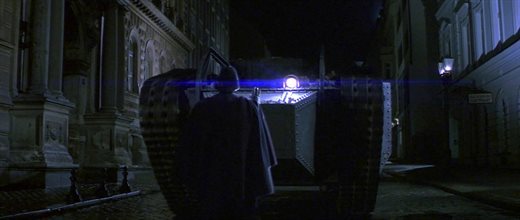
3) I have a feeling Germany would not actually say this verbatim in a situation like this.

4) So I absolutely love the idea of taking The Phantom of the Opera and making him into the big bad technical war-mongering genius the League has to fight in this film. I love the idea, but I feel the execution is a little sloppy. Combining The Phantom’s with James Moriarty utterly takes away any sympathy we have for the character. In Gaston Leorux’s original novel, The Phantom was a figure of tragedy and heartache. I would’ve loved to see more of that side of him, to understand why The Phantom wants to start a World War and what that pain means for him. But instead we get sort of the cliché, “bad guy wants to start war to get rich,” scheme which may be very much in the vein of Moriarty but not in the vein of the Phantom of the Opera.
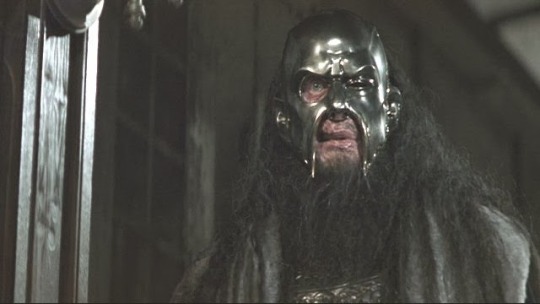
5) Sean Connery as...
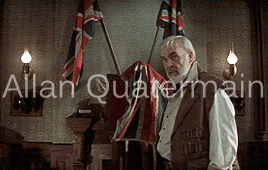
According to IMDb:
Sean Connery was offered roles in The Matrix (1999) and The Lord of the Rings: The Fellowship of the Ring (2001), but said he didn't understand the scripts. So when offered another screenplay he didn't quite get, (LEG) he took it.
Connery hated working on this film. Absolutely hated it. There were constant production delays and he clashed frequently with director Stephen Norrington (who also hated working on the film, mainly from studio pressures). Connery has retired from acting pretty much because of this film. It was this film which convinced him that he’d fallen out of love with modern filmmaking. In the 14 years since LXG’s release Connery has only had two other acting roles: voicing James Bond in a video game version of From Russia with Love and as the titular character in the poorly received animated film Sir Billi.
Among the many liberties the film takes with the source material, it removes a lot of Quatermaine’s flaws. Yes the pain of losing his son is a nice source of conflict for the character, but this dude was messed up in the original story. His primary character flaw being his addiction to opium, but Connery refused to play an opium addict. The decision to remove this sort of defining flaw makes Connery’s portrayal of the character sort of a generic action hero, at least that’s how I feel. He’s pretty much playing Sean Connery, for better or worse. He never does anything totally unexpected or unique (again, in my opinion) and that hurts the film I think. Connery’s fine in the part. Again, he’s pretty much playing himself. It’s not worthy of a Razzie or anything. But it’s just...fine.
6) There are some really awful bits of dialogue in this film, not helped by exceptionally wooden delivery on some occasion.
Sanderson Reed [as a shootout begins]: “They’re indestructible!”
Allan: “No, just armor plated.”
7) One of the most interesting aspects of Quatermaine is his skills as a hunter and later his sharing of those skills with Tom Sawyer (more on that later). It is a side to him I wish we could’ve seen more of. Patient, steady, able to get off one good shot instead of a dozen fine ones.
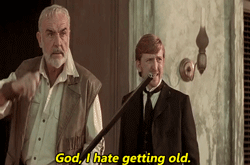

(GIFs originally posted by @mercisnm)
8) There are so many random name drops and references in this film which are just done to remind you you’re in a world of fictional characters. Some of them work, but some of them feel REALLY awkward.
Allan [after Reed says he made good time to London]: “Not as good as Phileas Fogg. Around the world in 80 days? Ha!”
So basically you referenced something and then thought the audience was too stupid to get the reference and just said the name of the book. Great.
9) Richard Roxburgh as M/The Phantom/Moriarty
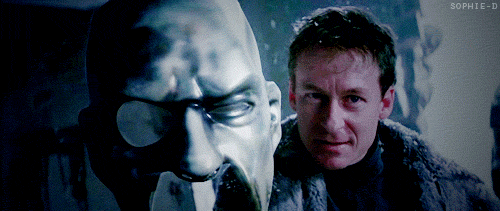
This film is FILLED with talented character actors and Roxburgh is one of them. In fact, he’s one of the finest character actors around. With notable roles in Van Helsing, Moulin Rouge, and the lead role in “Rake” (Australian TV show), Roxburgh is able to play a wide array of interesting characters. While this film may lack in some plot and structure, there are a number of performances which I find extraordinary (no pun intended). Roxburgh is able to play the calm and collected gentlemen M, the mad warlord The Phantom, and the conniving scoundrel James Moriarty all in the same character. Three different opportunities shown in one character, all of which done totally and excellently. If only the script would support these opportunities and differences better.
10) In continuing the theme of fine (fine as in exquisite, not fine as in “it’s just fine”) character actors in the movie: Naseeruddin Shah as...
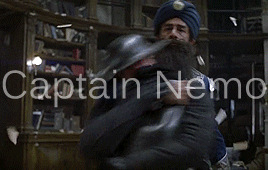
(GIF originally posted by @barbara-stanwyck)
Hey would you look at that: an actual Indian actor playing a character who was originally written as Indian in a major Hollywood film from 14 years ago! What a concept!
Shah is another actor who is pretty damn great in the role he plays, if only the script would have supported it more. He is able to portray Nemo’s authority and skill in presence alone. When Captain Nemo enters the room you KNOW he’s someone you don’t want to mess with. He is powerful, reserved, but also able to convey Nemo’s pain when necessary. Honestly for all this films problems there are some members of the cast who I just truly love, and Shah as Nemo is one of them.
11) Another member of the cast I think just freaking nails it is Tony Curran as Rodney Skinner/An Invisible Man (not THE Invisible Man, but more on that later).

According to IMDb:
20th Century Fox was unable to get the rights for the literary character of The Invisible Man, created by H.G. Wells. Not only did this necessitate the character in the film have his name changed from the book's "Griffin", but that he could never be referred to as "the" Invisible Man, only "an" invisible man.
Honestly the change works much better than you might think as Skinner is one of the most likable characters in the film. Curran is able to make his charismatic, devilish, witty, and entertaining for someone who is typically never seen. Unfortunately he sorta disappears around the middle (and the film is worse for it), but Curran is another talented character actor who does an excellent job in the film.
12) Peta Wilson as Mina Harker.
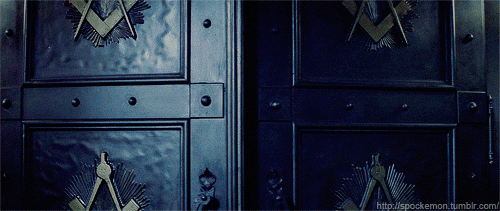
So...Mina...I don’t really know where to start with Mina. She’s the leader of the League in the original graphic novel, not Alan Quartermaine. She also is NOT a vampire, is dealing with trauma over her encounter with Dracula, and is seen to be a bisexual suffragist (or at least, Alan Moore’s understanding of what that is). A lot of that is lost in the film, and while her vampirism does lead to some badass moments Mina’s motivations are...I’m not sure, actually. I would assume she wants to stop the spread of evil throughout the world to prevent another Dracula, but she has some weird past romance with Dorian Gray and gets sassy with Allan when he acts sexist and...that’s it? Wilson is another strong character actor in the film, but I feel the script supports her even less than it supports say Captain Nemo and Skinner. I’m actually not sure what else to say about Mina.
13) Why does Sean Connery play so many sexist characters?
Connery [to Mina]: “I’ve had women along on past exploits and found them at best a distraction.
Maybe if you didn’t objectify them and trusted their competence you wouldn’t be so distracted.
14) So if you pay attention, right before The League visits Dorian Gray there are newspapers plastered up on the wall of a building talking about Mars (pretty much the words “Mars” is really big). This is in reference to the second volume of the comic book which dealt with The League fighting off HG Welles’ aliens from War of the Worlds. I like that volume more than the first personally, but like a lot (if not all) of Alan Moore’s work it can be problematic. Anyway, moving on.
15) Dorian Gray.

Unfortunately I feel like Stuart Townsend is one of the weakest actors in the film as Dorian, but that could also be attributed to Stephen Norrington’s direction (theoretically, it’s not like I was on set or anything). He’s kind of overact-y, portraying Dorian’s self assuredness and vanity in a way which kind of makes him a prick. Another character not originally in the novel, I don’t think the film necessarily needed Dorian Gray. Although he does have one of my favorite lines in the film.
Bad guy [after he shoots up Dorian to no effect]]: “What are you?”
Dorian: “I’m complicated.”
16) Tom Sawyer.

Tom Sawyer is pretty much Tom Sawyer in name alone. He has little-to-nothing in common with Mark Twain’s original character, being a secret service agent instead of a devious little trickster who’s always getting out of work. The studio asked for him to be included as they felt the movie needed an American character to be interesting to stateside audiences. Since he’s not in the original work and he’s not really Tom Sawyer, he ends up being kind of another generic action trope. A shoot-em-up rookie who learns from the more experienced Quatermaine and that’s it. They cut a line which explains that Tom is so desperate to get The Phantom/M/Moriarty because he killed his partner (one Huck Finn) but that’s literally his only unique motivating character factor. And it got cut. It’s done and gone. So we’re just left with...this. Shane West is OK in the film, but the script doesn’t give him much to do in the first place.
17) I’m disappointed with the design of the Nautilus.

Nemo calls it, “The sword of the ocean,” and I’m just wondering if they couldn’t have let that be a bit more metaphorical instead of looking like a giant sword.
18) At one point Mina does an impression of Allan/Sean Connery. According to IMDb:
According to Wilson, this was a last-minute addition to the scene, and she felt nervous doing it, since Connery impersonations were considered a no-no on the set. Before the shoot she called Connery and offered not to do the accent, but he insisted she should. Afterwards, she asked him what he thought. He replied, "You were great!" She was taken aback and asked if he really meant it. He said, "Yeah, it's terrible! It's the worst impersonation I have ever heard, and it's perfect."
19) Jason Flemyng as Dr. Jekyll/Mr. Hyde.
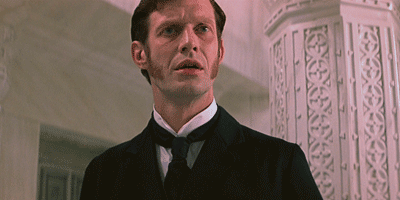
Jason Flemyng is another one of my favorite character actors - having notable post-LXG roles in X-Men First Class and 2010′s Clash of the Titans - and may tie with Tony Curran as my favorite actor in this film. Flemyng is able to capture both Jekyll and Hyde very well, making them unique in and of themselves. I have to remind myself that they’re the same actor considering the heavy amount of makeup Flemyng is put into for Hyde. But he brings a wonderful physicality to the part which I think is just spectacular. Unfortunately - again - the script does very little to support his performance and the actor gets a little lost in the middle. A great performance even if I wish it were better written.
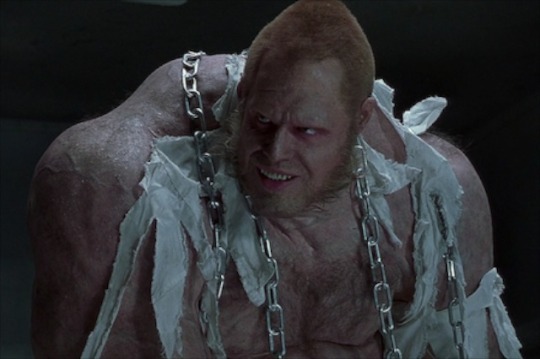
20) Gathering the League feels totally inorganic, unfortunately. Literally the first half of the film is, “let’s get him and let’s get him and let’s get him,” without actually contributing to the overall plot with The Phantom and the impending World War. It is very telling of the film’s biggest problem and that is the one it has with structure and pacing. Everything feels very messy, with not much thought put into why some scenes exist or play out the way they do. Which is unfortunate again because you have a mostly-stellar cast who are already pretty damn good with a crummy script. Imagine what they could do with a better one.
21) Allan teaching Tom how to shoot maybe my favorite part of the film. It not only connects to Allan’s own internal conflict with the loss of his son but it also taught me - at 13 years old - how important patience can be. Just breathe and take your time. It’s better to get off one perfect shot than a dozen shitty ones.
22) So in the course of about ten minutes it is established that both Tom and Jekyll are into Mina even though nothing from before gives them reason to be and they never once revisit it after. Remember how I said this film had some structural issues? Well it has some developmental issues too.
23) This film is an hour and fifty minutes. It takes them fifty-five minutes to get to Venice - where they’ve been trying to get to the whole time - and then the bomb goes off right away (literally) and they have to stop it. The plot is literally: assemble the league, go to Venice, get to Venice and stop the disaster. Nothing in between. Again: this film has some major structural issues.
24)
Jekyll [after he’s asked to bring Hyde out]: “No! Hyde will never use me again.”
Dorian: “Then what good are you?”
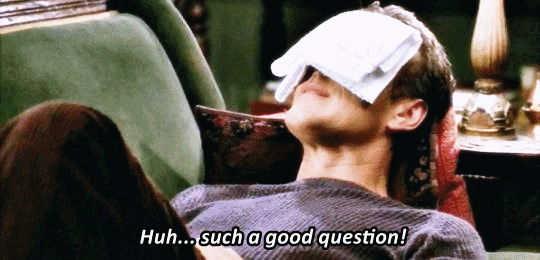
(GIF originally posted by @marshmallow-the-vampire-slayer)
Seriously, why did they bring Jekyll around? Did they only need Hyde? And if so, for what? I know M wants the serum for Hyde but what about the rest of them? What convinced them to bring Hyde along and then be okay with him not doing anything on their big mission?
25) Another example of an extremely wooden delivery. This line hurts my soul every time, although in fairness Dorian himself is supposed to be faking it.
Dorian: “Damn Skinner! He must’ve told them we were coming!”
It hurts my ears, that line. I hate it. So much.
26) I have so many questions about the car chase through Venice. How does Tom know to drive a car? Why is the car designed like it’s American with the wheel on the left? How can Nemo track the car’s “frequency”? Who does the car have a frequency, it is never seen using the radio? I’m so confused.
27) This is the weirdest James Bond movie ever.
Allan: “Vampire lady has us covered.”
28) The scene where Alan faces off with The Phantom in the Venice graveyard is close to interesting. If The Phantom were more developed as an individual and it took its time to peek into Alan’s internal conflict, it could’ve been an excellent character moment.
29)
M [revealing his entire plan via a record]: “It was a ruse to get me closer to my goal.”
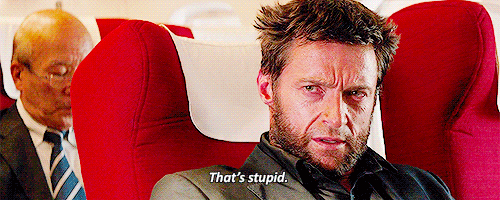
(GIF source unknown [if this is your GIF please let me know].)
So M wanted the technology to the Nautilus, Hyde’s serum, Mina’s vampirism, and Griffin’s invisibility. And here’s how that plan worked: rob an English bank disguised as Germans, kidnap German scientists disguised as the English, try to convince Quatermaine to join a fake League I made up, try to kill Quatermaine to show him the danger is real, send the League I have already to get Dorian who is a traitor in their midst, try to kill them all with Dorian to convince them the danger is real, have Dorian steal what I need from everyone, blow up Venice, have Dorian escape.

(GIF originally posted by @dailydctv)
If you already had Dorian and an army of minions at your service, couldn’t you have sent them to get what you need from everyone? Wouldn’t that have been easier and less expensive? I’m just...I think I need to move on.
30) The best part of the sinking Nautilus is Jason Flemyng really gets to shine as Hyde. Except it makes no sense that Hyde suddenly doesn’t want to betray and murder everyone for his own personal gain but actually wants to work with the team. There was absolutely nothing to change that character motivation. At all.
31)
Quatermaine [after the Nautilus is trashed, about pursuing Dorian]: “We were the faster, but now we’re the tortoise to his hare.”
Except the tortoise won that race. Did you not understand the point of the story?
32) And then a random white tiger shows up, stares at Quatermaine, and leaves.
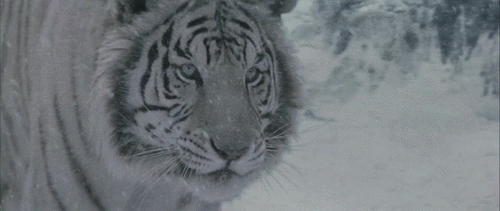
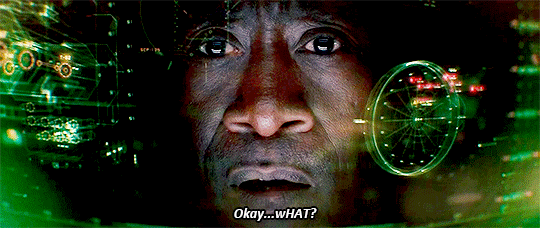
(GIF source unknown [if this is your GIF please let me know].)
I know it’s supposed to tie into how Allan feels his an old tiger sensing the end but it’s also just totally random. And like, did you need an actual tiger? There’s no subtly to that. At all. You’re just taking the metaphor literally and not trusting the intelligence of the audience. I just...gah.
33)
Skinner [after slapping Mina’s as while invisible]: “I’ve been waiting all week to do that.”
To sexually harass her? Well, you’re still not as awful as how Alan Moore wrote The Invisible Man in the story.
34) Like all the set pieces in this film, the climax is poorly paced and sort of dull. You keep cutting between Hyde and Nemo fighting a weird Hyde clone (which, btw, is not how the serum works in the original novel; it’s not Hulk juice), Mina fighting Dorian in a bedroom because she claims, “You broke my heart once,” (really?) Allan and Sawyer chasing down M who is revealed to be Sherlock Holmes’ Moriarty, and Skinner just being somewhere and then getting burned. It’s just...meh.
35) Also should looking at the painting kill Dorian? Is that how it worked in the original novel? I thought if you stabbed the painting it killed him or something.
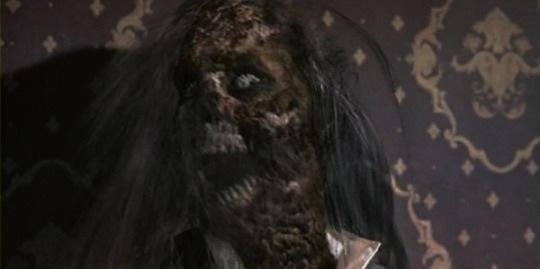
36) In an actually somewhat developed part of the film, Sawyer shoots Moriarty remembering Allan’s teachings about patience.

37) And then Alan dies, but not really because they wanted to do a sequel and totally set up him coming back from the dead. Too bad this killed the potential of a franchise.
This film was a lot less enjoyable as an adult than it was when I was in high school, but I’m also analyzing it for the (Re)Watch. Yes the story is a muddled mess with underdeveloped characters and concepts which just really don’t make any sense. Yes Sean Connery is sort of just showing up. BUT it’s largely well acted and come one! It’s a film where Tom Sawyer shoots James Moriarty in the back after being taught by Allan Quatermaine how to do it. I’m a sucker for crossovers so this is still a total guilty pleasure. Don’t watch it if you’re not interested, because it’s pretty crummy. But it might be enjoyable for the individual who’s interested in these kind of stories.
#The League of Extraordinary Gentlemen#Sean Connery#Richard Roxburgh#Jason Flemyng#Tony Curran#Naseeruddin Shah#Peta Wilson#Stuart Townsend#Shane West#Epic Movie (Re)Watch#Movie#Film#GIF
19 notes
·
View notes
Text
Week 9
The murder of Danvers Carew 2.0
The street was silent, with only the sounds of my footsteps to fill it. The frost stuck to my coat, my misty breathe mixed with the smoke from my cigar. I felt each draw sent a warm current flowing through my body, forcing a cracking smile onto my face as if it wasn’t my own.
I’m searching for something, someone. I need to see them, our sort of meetings were frowned upon by my others, the ones that knew. It seen as a taboo, done only in secret, in hidden dark rooms where no one could see or hear, always at risk.
As moon became the center of the sky, I searched the streets, finally catching a glance of someone, standing in the moonlight looking up. It wasn’t who I was looking for, their tall board appearance was different but still alluring, his body was of a man in his mid 20’s but his hair that of older gentlemen. I hid from his sight, I felt my starting to race heart as I saw but I didn’t move to greet him. I moved to call him again but my body still wouldn’t move, I stayed still, hunched over, grunting quietly, watching.
The man ahead of me seemed lost in his own mind as I moved slowly towards him. I feel a crooked grin appearing across my face as I approached. My hand grips tightly around the body of my cane, I feel my pulse start to race faster. My body approaching him from behind, I straighten my back and raise hand.
He turns around and looks at me in the eye, I realise it’s him.
Time pauses as I stare into his eyes, the days we spent together, the long nights we spent embraced hidden away. High society would have us locked up with real monsters or worse if it ever went public of what we were. I feel something struggling against me as I try to drop my cane my grip only gets tighter, my face starts to hurt as I feel the smile on my face get larger, the skin around my lips starting to tear, as the pain gets worse I feel myself getting weaker and lose the battle for control.
My cane strikes down, crashing against his head. Blood spraying against my coat as body continues to bash against my will and break the body below me. A monstrous laugh breaks from my lips, a cigar falling from my mouth onto the mangled body below me. The cane is thrown to my side, my hands wrap around his head, squeezing, crushing, cracking his skull, for the one final scream.
I awoke, sweat coating my body, I’m shaking. It takes me a minute to realise, I’m in not in my own room
This is not the first time I’ve woken up here.
I feel cramped, it feels like the low ceiling and the dark red walls enclosing on me. Blood covered my clothes and hands, I wiped my face to find even more gore, my stomach wrenches as last night's events force themselves into my mind, as if by another.
The man I killed, his face still fresh in my mind, Danvers, an old lover, and friend. We were supposed to meet and talk about the past. We missed it, and wanted to live it again, even for a night but Mr Hyde didn’t approve.
---
The analysis of Short Story inspired by Dr Jekyll and Mr Hyde
This is essay I will be analysing my own adaption of Dr Jekyll and Mr Hyde in the form of a 500 word short story. I after reading the book, I took a short few pages from the book, the murder of Mr Danvers swapped to the view of another, Dr Jekyll instead of the maid.
When reading the book, I found a few chapters which gave me a interesting view into the characters which might not have been perceived at the time by the author or his wife. These few modern views of the story lead to me write an adaptation where Dr Jekyll is homosexual but must hide it due to victorian society's view of homosexuals, while Mr Hyde is Dr Jekyll’s want and need to be straight so he can fit in with said society and be happy while doing it, since it wasn’t only frowned upon but a prisonable offence. I touch on this subject in my writing, “It seen as a taboo, done only in secret, in hidden dark rooms where no one could see or hear, always at risk” and “High society would have us locked up with real monsters or worse if it ever went public of what we were”
One of the most known cases that showed victorian society’s view of homosexuality and how it was treated in the era, Mason(2015) states that...
“...The famous imprisonment of author Oscar Wilde in 1895 for being a homosexual paints a picture of sexual repression and hostility towards same-sex relationships in 19th-century England.”
This quote I believe helps paint a picture party what it was like to be homosexual in the victorian era. If man was caught doing “buggary” or homosexual intercourse, that person would be taken to trial, then either locked up, forced to undergo a series of medieval conversion therapies or in a worse case scenario sentenced to death.
One of the lines that gave me the idea for the homosexual themes in my adaption, was one by Mr Utterson when he describes Dr Jekyll with such dedicated detail, Stevenson, R.(1886, P.23) states that-
“Dr. Jekyll was no exception; and as he now sat on the opposite side of the fire — a large, well-made, smooth-faced man of fifty, with something of a slyish cast perhaps, but every mark of capacity and kindness”
This loving detail gave me my first piece of inspiration, in my mind, Mr Utterson seems to adore the man more than anything, more than a friend would. This set the idea in my mind about some of the characters being homosexual or apart of the LGBTQ+ spectrum. Another line by Mr utterson dreams about Dr Jekyll, Stevenson, R.(1886, P.15) states that-
“...Or else he would see a room in a rich house, where his friend lay asleep, dreaming and smiling at his dreams”
Taking inspiration from another media and take on Dr Jekyll and Mr Hyde in more of a Bruce Banner and the Hulk way was League of Extraordinary Gentlemen by Alan Moore and Illustrated by Kevin O’Neill. During a Dinner party scene between Hyde, Captain Nemo and the coachman, William Samson Sr, Hyde brings up his origins stemming from Jekyll wanting to “purge” himself of sin and upon the coachman’s comment on how a doctor mustn't have many sins to purge, Hyde reveals his alter-ego (and possible by extension his own) sexuality in relation to men, Moore, A. O’Neill.(2002) states that
“...Oh and he played with himself, sometimes while he thought about other men…”
Even though the writing Alan Moore is a bit eccentric, He also adds to my own idea of Hyde being created to make Jekyll straight or that Hyde was his need/want to be straight, Moore, A. O’Neill.(2002) states that-
“Anyway, what that silly bastard did, he thought he quarantined all these bad parts, what left would be a ****ing ANGEL…”
I believe the Mr Hyde from League is stemming from Jekyll’s repressed sexuality, and his history of violence against women which is shown in volume 1 of the book. When looking for a murderer, Wilhemina Murray and Allan Quatermain are sent to find Hyde--at this point a man they believe to be just Dr. Jekyll who has been murdering prostitutes in Paris. With Alan Moore’s flare for dramatic violence this could be seen as his way of demonstrating Jekyll’s frustrations with women, sexuality and his own urges for the same sex. If I chose to continue this adaption, I’d like to incorporate this, I would turn down the abuse of women for my own version, Alan Moore writes abuse of women, like it’s as normal as breathing.
Between reading the book and writing my own adaptation to the story I started thinking of the types of animation that could be applied to a the original story and my own, since the original has already been shown and retold so many times using live action while it has only been told a few times via animation.
All forms of animation could work well, we have the classic traditional 2D which has been done before in 1986 by Maricia Hatfield and by Warner Brothers during 1955 in the Bugs Bunny short Hyde and Hare but I think how both Dr Jekyll and Mr Hyde are animated could be taken a lot further with some hybrid animation to show how each of the different sides view the world around them, and how they are viewed as well. Since Jekyll and Hyde are shown to be such different characters, and from my view even the way they see the world of Jekyll and Hyde could be different which leads me to the idea of hybrid animation.
My story relies on Hyde being Jekyll’s want/need to be straight, which in my mind could make Hyde almost the distorted version of Dr Jekyll to himself, translating from Jekyll and his worlds type of animation to a different one. This could be shown by Dr Jekyll being a in CG world which would be quite shiny, clean going along with how others see him, while Mr Hyde could be in a stop motion puppet based around Jekyll’s cg model but made out of plasticine allowing the constant change of Mr Hyde’s appearance as he gets ‘stronger’ taking on more of Jekyll’s physical traits as Jekyll believes he’s becoming straight while Jekyll himself is becoming more like Hyde, shorter, more deformed similar to what Hyde explains happened to himself in ‘The League of Extraordinary Gentlemen Volume 2, Moore, A. O’Neill.(2002, P.22) states that-
“I mean, when I started out, good GOD, I was practically a ****ing dwarf. Jekyll, on the other hand, a Great big strapping fellow.”
While also being a call back to the original lecture of Jekyll and Hyde, in the book ‘The League of Extraordinary Gentlemen’ which is set a good few years after the original book, Hyde is now a giant of a man, while Jekyll is average size but extremely un well as shown by O’Neill.(2002, P.7 V1, P11 V2) illustrations below left (P.11 , right) (page 7, chapter 2, volume 1)
To show the passage of Jekyll to Hyde, using shape theory in these animations, Jekyll in this version would be made up of mostly circles with a few squares spotted about at the start, while Hyde would take on more equal mixture of triangles and squares showing off his strength and evil by being what Jekyll needs him to be. Near the end of the animation it would end with Hyde becoming the ‘straight’ Jekyll taking on the more circles into this design, while Jekyll would have lost his parts of his circles in his shape for having lost such a big part of himself, making himself and Hyde more similar unlike what happened in League of Extraordinary Gentlemen.
In conclusion I believe I established the scene well and informed the viewer of the story and background of the time, all while trying to keep the viewer involved.
The backup for my inspiration could have had more behind it, I based it off the short parts of the main text, influences from previous writing and a modern look on it. I really like the concept of Jekyll behind a homosexual and Hyde being his side of himself he created to make himself straight, but I also like how Alan Moore writes Jekyll and Hyde, Moore, A (2002) states that -
“...Separating us in the first place, all because he wanted to be pure. ****ing Idiot”
While for the League, it was to separate Jekyll’s good and evil side, which explained why Mr Hyde was described as young, dwarf-like, since Jekyll was meant to be mostly good, and his evil in that story was new and hadn’t existed for long. My story had a version where Hyde was all of Jekyll’s want/need to be straight, leaving Jekyll completely gay until Hyde destroys everything and everyone that he believes make him gay.
Bibliography
Dr Jekyll and Mr Hyde.1986.http://www.imdb.com/title/tt0821767/ .[Online]
Emma Mason.07/04/15.The Victorians’ surprisingly liberal attitude towards gay men.[ONLINE].http://www.historyextra.com/article/sex-and-love/victorians%E2%80%99-surprisingly-liberal-attitude-towards-gay-men.[Accessed-01/02/2017]
Moore, A. O’Neill.(2002).The League of Extraordinary Gentlemen Volume 1.New York City, Vertigo Comics.(P.7)
Moore, A. O’Neill.(2002).The League of Extraordinary Gentlemen Volume 2.New York City, Vertigo Comics.(P.11, 22)
O’Neill.(2002).League of Extraordinary Gentlemen, Volume 1.[Book].http://www.comicsrecommended.com/images/others/loeg1_002_earshot.jpg. 2002.[Accessed - 01/01/2017]
O’Neill.(2002).League of Extraordinary Gentlemen, Volume 2.[Book].http://www.comicsrecommended.com/images/others/loeg1_002_earshot.jpg. 2002.[Accessed - 01/01/2017]
Stevenson, R.(1886).Strange Case of Dr Jekyll and Mr Hyde. London, PlaneteBook [online].http://www.planetebook.com/ebooks/The-Strange-Case-of-Dr-Jekyll.pdf.[Accessed-28/11/2016].(P.15, 23,
Timeline of LGBT history in the United Kingdom.NDF.https://en.wikipedia.org/wiki/Timeline_of_LGBT_history_in_the_United_Kingdom.[Online]
YOUTUBE.(11/05/2014).Hyde And Hare 1955.[Online].https://www.youtube.com/watch?v=nA7b1fuMTSQ.[Accessed-01/02/2017]
0 notes